air condition PONTIAC BONNEVILLE 1995 Owners Manual
[x] Cancel search | Manufacturer: PONTIAC, Model Year: 1995, Model line: BONNEVILLE, Model: PONTIAC BONNEVILLE 1995Pages: 338, PDF Size: 16.19 MB
Page 6 of 338
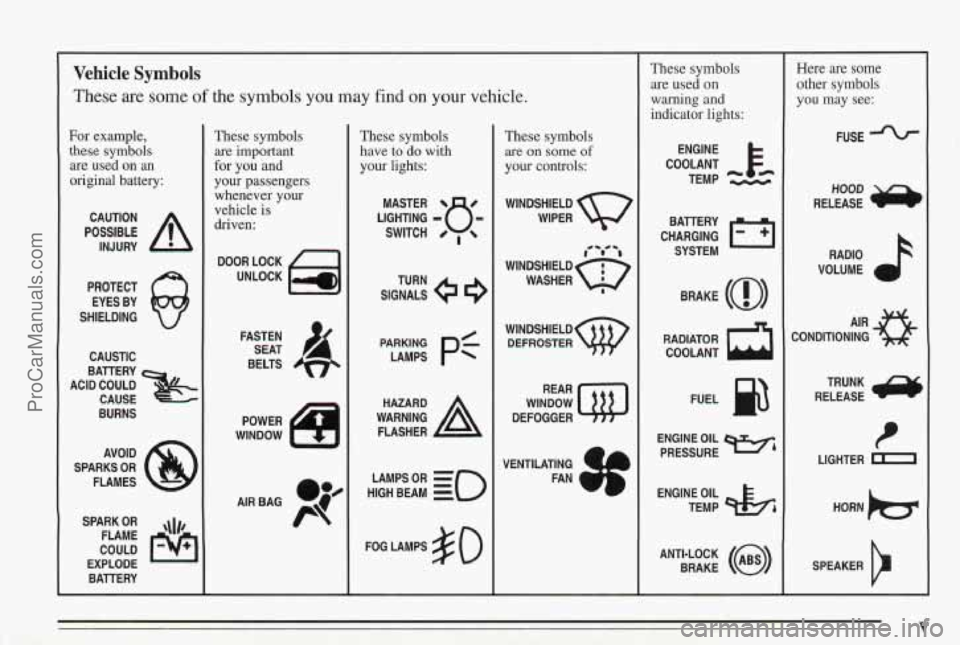
Vehicle Symbols
These are some of the symbols you may find on your vehicle.
For example,
these symbols
are used on
an
original battery:
POSSIBLE A
CAUTION
INJURY
PROTECT EYES BY
SHIELDING
CAUSTIC
ACID COULD BATTERY
CAUSE
BURNS
AVOID
SPARKS
OR
FLAMES
SPARK
OR ,\I/,
COULD FLAME
EXPLODE BAllERY
These symbols are
important
for you and
your passengers
whenever your
vehicle
is
driven:
DOOR LOCK
UNLOCK
FASTEN SEAT
4
BELTS
POWER
WINDNOW
These symbols
have
to do with
your lights:
SIGNALS 9
TURN
HIGH
LAMPSoR BEAM = =o
FOG LAMPS $0
These symbols
are on some of
your controls:
WIPER w
WINDsHIELDw DEFROSTER
WINDOW
DEFOGGER
VENTILATING
4 1
FAN CI
These symbols are used on
warning
and
indicator lights:
COOLANT Fe
TEMP --
ENGINE
CHARGING
I-1
BATTERY SYSTEM
BRAKE
(0)
RADIATOR COOLANT
a
FUEL @
ENGINE OIL
PRESSURE Wb
TEMP OIL 45
ANTI-LOCK (@)
BRAKE
Here are some
other symbols
you may see:
FUSE
RADIO
VOLUME
CONDITIONING
AIR 43
TRUNK
RELEASE
t
LIGHTER n
SPEAKER
V ProCarManuals.com
Page 122 of 338
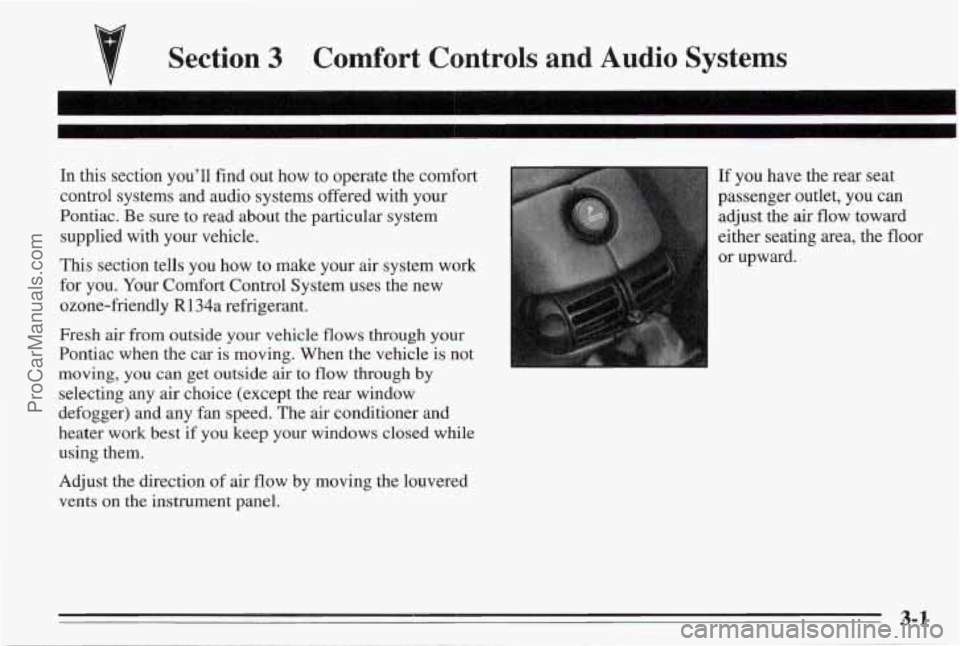
Section 3 Comfort Controls and Audio Systems
In this section you’ll find out how to operate the comfort
control systems and audio systems offered with your
Pontiac. Be sure to read about the particular system
supplied with your vehicle.
This section tells you how to make your air system work
for you. Your Comfort Control System uses the new
ozone-friendly R134a refrigerant.
Fresh air
from outside your vehicle flows through your
Pontiac when the car is moving. When the vehicle
is not
moving, you can get outside air
to flow through by
selecting any
air choice (except the rear window
defogger) and any fan speed. The air conditioner and
heater work best if you keep your windows closed while
using them. If
you have the rear seat
passenger outlet, you can
adjust the
air flow toward
either seating area, the floor
or upward.
Adjust the direction
of air flow by moving the louvered
vents on the instrument panel.
ProCarManuals.com
Page 123 of 338
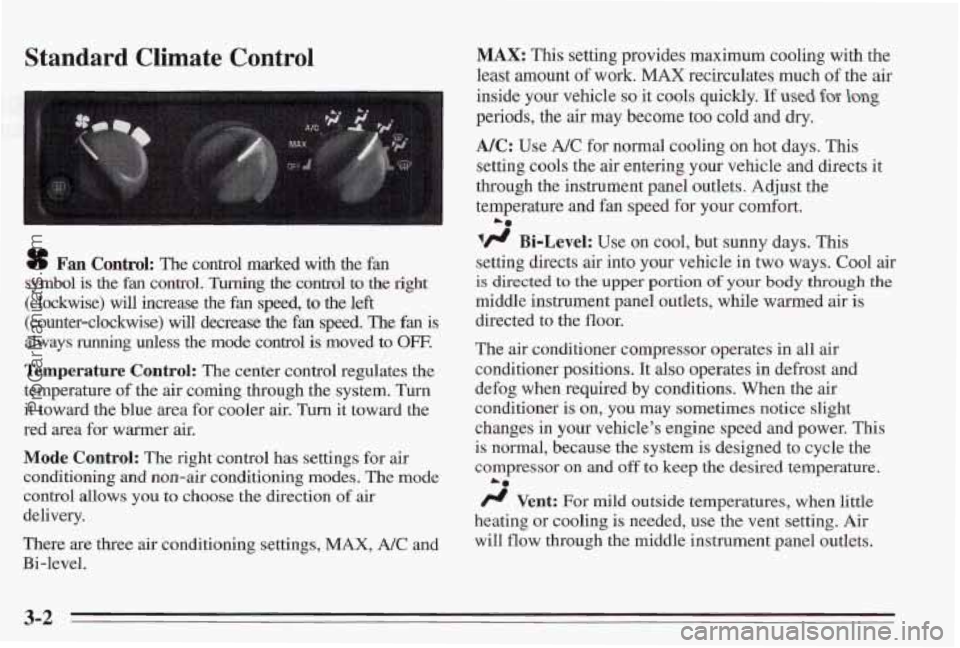
Standard Climate Control
sf Fan Control: The control marked with the fan
symbol is
the fan control. Turning the control to the right
(clockwise) will increase the fan speed, to the left
(counter-clockwise) will decrease the fan speed. The fan is
always running unless the mode control is moved to OFF.
Temperature Control: The center control regulates the
temperature
of the air coming through the system. Turn
it toward the blue area for cooler air.
Turn it toward the
red area for warmer air.
Mode Control: The right control has settings for air
conditioning and non-air conditioning modes.
The mode
control allows
you to choose the direction of air
delivery.
There are three air conditioning settings,
MAX, A/C and
Bi-level.
MAX: This setting provides maximum cooling with the
least amount
of work. MAX recirculates much of the air
inside your vehicle
so it cools quickly. If used for- long
periods, the air may become too cold and dry.
NC: Use A/C for normal cooling on hot days. This
setting cools the air entering your vehicle and directs it
through the instrument panel outlets. Adjust the
temperature
and fan speed for your comfort.
lfl Bi-Level: Use on cool, but sunny days. This
setting directs air into your vehlcle in two ways. Cool air
is directed to the upper portion of your body through the
middle instrument panel outlets, while warmed air is
directed to the floor.
The
air conditioner compressor operates in all air
conditioner positions. It also operates in defrost and
defog when required by conditions. When the
air
conditioner is on, you may sometimes notice slight
changes
in your vehicle’s engine speed and power. This
is
normal, because the system is designed to cycle the
compressor on
and off to keep the desired temperature.
/J Vent: For mild outside temperatures, when little
heating or cooling is needed, use the vent setting. Air
will
flow through the middle instrument panel outlets.
La
3-2
ProCarManuals.com
Page 124 of 338
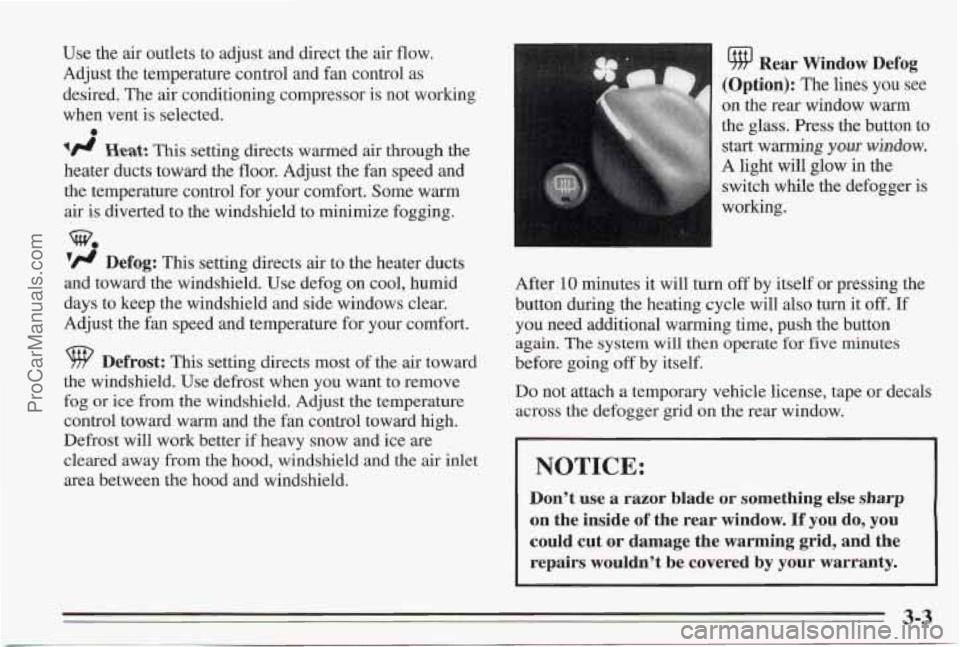
Use the air outlets to adjust and direct the air flow.
Adjust the temperature control and fan control as
desired. The air conditioning compressor is not working
when vent is selected.
I# Heat: This setting directs warmed air through the
heater ducts toward the floor. Adjust the fan speed and
the temperature control for your comfort. Some warm
air is diverted to the windshield to minimize fogging.
'fl Defog: This setting directs air to the heater ducts
and toward the windshield. Use defog on cool, humid
days to keep the windshield and side windows clear.
Adjust the fan speed and temperature for your cornfort.
9 Defrost: This setting directs most of the air toward
the windshield. Use defrost when you want to remove
fog or ice from the windshi'eld. Adjust the temperature
control toward
warm and the fan control toward high.
Defrost will work better if heavy snow and ice
are
cleared away from the hood, windshield and the air inlet
area between the hood and windshield.
0
w.
u/HI Rear Window Defog
(Option): The lines you see
on the rear window warm
the glass. Press the button to
A light
will glow in the
switch while the defogger is
working. start
warming ymr wlndow.
After 10 minutes it
will turn off by itself or pressing the
button during the heating cycle will
also turn it off. If
you need additional warming time, push the button
again. The system will then operate for five rninutes
before going off by itself.
Do not attach a temporary vehicle license, tape or decals
across the defogger grid
on the rear window.
NOTICE:
Don't use a razor blade or something else sharp
on the inside of the rear window. If you do, you
could cut or damage the warming grid, and the
repairs wouldn't be covered
by your warranty.
3-3
ProCarManuals.com
Page 125 of 338
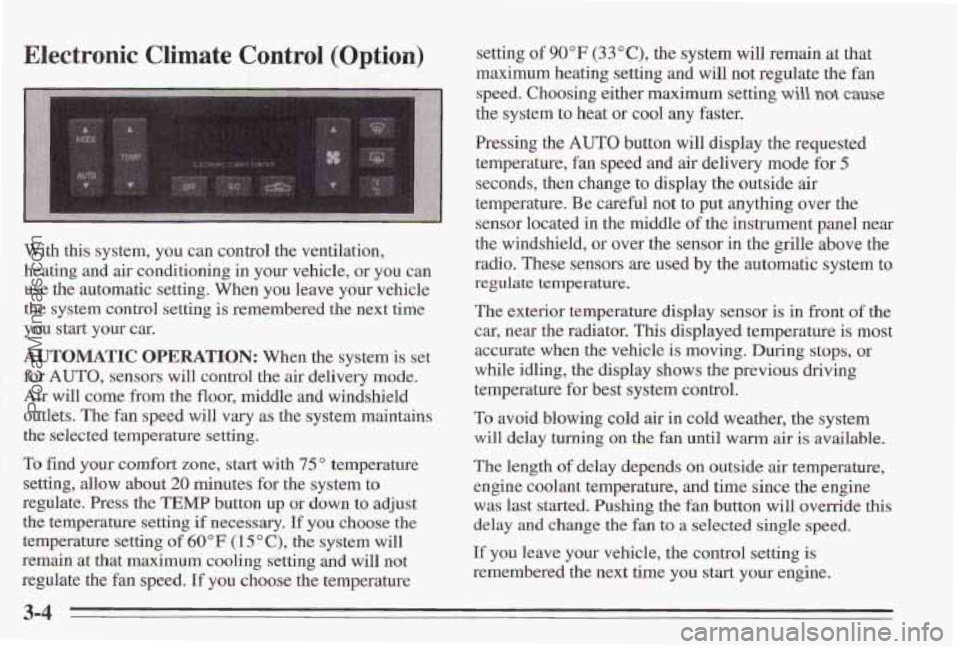
Electronic Climate Control (Option)
With this system, you can control the ventilation,
heating and
air conditioning in your vehicle, or you can
use the automatic setting. When
you leave your vehicle
the system control setting
is remembered the next time
you start your
car.
AUTOMATIC OPERATION: When the system is set
for
AUTO, sensors will control the air delivery mode.
Air will come from the floor, middle and windshield
outlets. The fan speed will
vary as the system maintains
the selected temperature setting.
To find your comfort
zone, start with 75" temperature
setting, allow about
20 minutes for the system to
regulate. Press the
TEMP button up or down to adjust
the temperature setting
if necessary, If you choose the
temperature
setting of 60°F (1 5 O C), the system will
remain at that maximum cooling setting and will not
regulate the fan speed.
If you choose the temperature setting
of 90°F (33"C), the system
will remain at that
maximum heating setting and will
not regulate the fan
speed. Choosing either maximum setting
will not cause
the system to heat or cool any faster.
Pressing the
AUTO button will display the requested
temperature, fan speed and air delivery mode for
5
seconds, then change to display the outside air
temperature. Be careful not to put anything over the
sensor located in the middle
of the instrument panel near
the windshield, or over the sensor in the
grille above the
radio. These sensors are used by the automatic system to
regulate temperature.
The exterior temperature display sensor is in front of the
car, near the radiator,
This displayed temperature is most
accurate when the vehicle is moving. During stops,
or
while idling, the display shows the previous driving
temperature for best system control.
To avoid blowing cold air in cold weather, the system
will delay turning on the
fan until warm air is available.
The length
of delay depeds on outside air temperature,
engine coolant temperature, and time since the engine
was last started. Pushing the
fan button will override this
delay and change the fan
to a selected single speed.
If you leave your vehicle, the control setting is
remembered the next time you start your engine.
3-4
ProCarManuals.com
Page 126 of 338
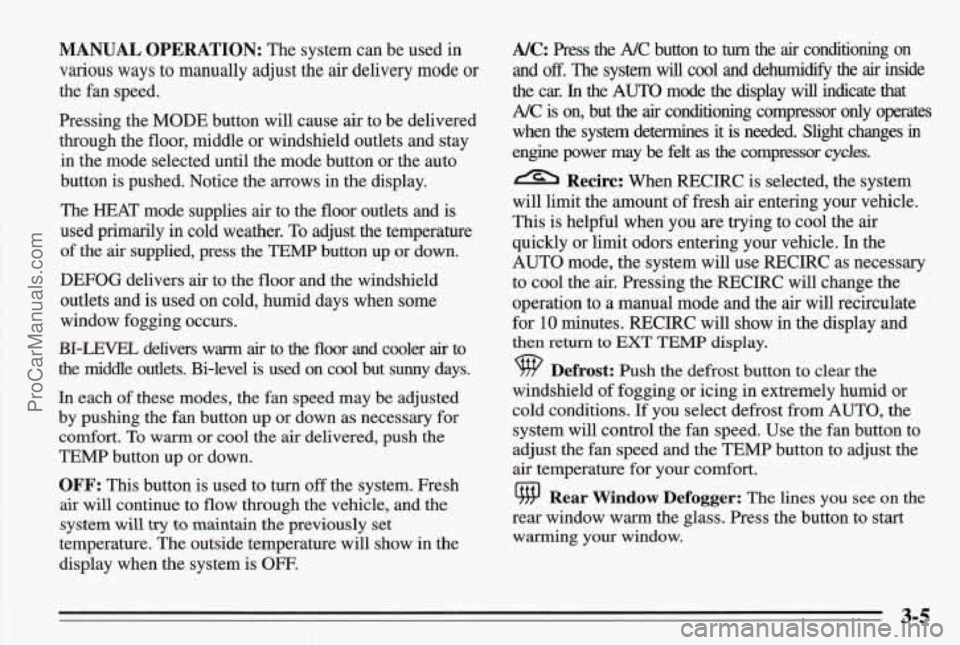
MANUAL OPERATION: The system can be used in
various ways to manually adjust the air delivery mode or
the fan speed.
Pressing the
MODE button will cause air to be delivered
through the floor, middle or windshield outlets and stay in the mode selected until the mode button or the auto
button is pushed. Notice the arrows
in the display.
The HEAT mode supplies
air to the floor outlets and is
used primarily in cold weather. To adjust the temperature
of the air supplied, press the TEMP button up or down.
DEFOG delivers air to the floor and the windshield
outlets and is used on cold, humid days when
some
window fogging occurs.
BI-LEVEL delivers warm air to the floor and cooler air to
the middle outlets. Bi-level
is used on cool but sunny days.
In each of these modes, the fan speed may be adjusted
by pushing the fan button up or down as necessary for
comfort.
To warrn or cool the air delivered, push the
TEMP button up or down.
OFF: This button is used to turn off the system. Fresh
air will continue to flow through the vehicle, and the
system
will try to maintain the previously set
temperature.
The outside temperature will show in the
display when the system is
OFF.
A/C: Press the A/C button to turn the air conditioning on
and
off. The system will cool and dehumidfy the air inside
the car.
In the AUTO mode the display will indicate that
A/C is on, but the air conditioning compressor only operates
when the system determines it
is needed. Slight changes in
engine power may be felt as the compressor cydes.
Recirc: When RECIRC is selected, the system
will limit the amount of fresh air entering your vehicle.
This is helpful when you are trying to cool the air
quickly or limit odors entering your vehicle. In the
AUTO mode, the system will use RECIRC as necessary
to cool the air. Pressing the RECIRC will change
the
operation to a manual mode and the air will recirculate
for
10 minutes. RECIRC will show in the display and
then return to EXT TEMP display.
9 Defrost: Push the defrost button to clear the
windshield of fogging or icing in extremely humid or
cold conditions. If you select defrost from
AUTO, the
system will control the fan speed. Use the fan button to
adjust the fan speed and the TEMP button to adjust the
air temperature for your comfort.
rear window warm the glass. Press the button to start
warming your window.
Rear Window Defogger: The lines you see on the
3-5
ProCarManuals.com
Page 137 of 338
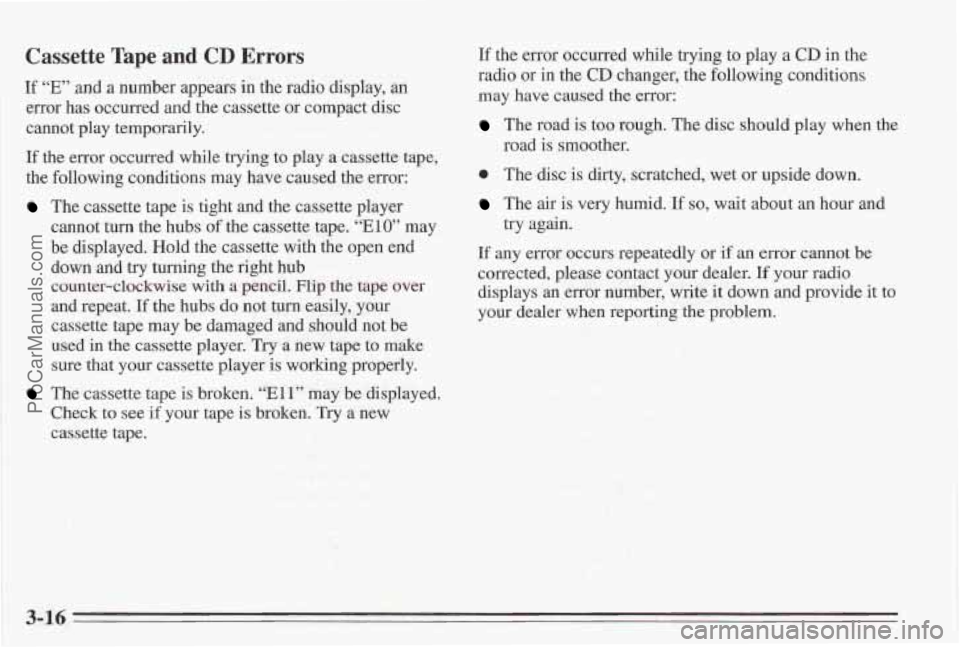
Cassette Tape and CD Errors
If “E” and a number appears in the radio display, an
error has occurred and the cassette or compact disc
cannot play temporarily.
If the error occurred while trying to play a cassette tape,
the following conditions may have caused the error:
The cassette tape is tight and the cassette player
cannot
turn the hubs of the cassette tape. “E10” may
be displayed.
Hold the cassette with the open end
down and try turning the right hub
counter-clockwise
with a pencil. Flip the tiq% dmr
and repeat. If the hubs do not turn easily, your
cassette tape may be damaged and should not be
used
in the cassette player. Try a new tape to make
sure that your cassette player is working properly.
The cassette tape is broken. “El 1” may be displayed.
Check to see if your tape is broken.
Try a new
cassette tape.
If the error occurred while trying to play a CD in the
radio or in the
CD changer, the following conditions
may have caused the error:
The road is too rough. The disc should play when the
road is smoother.
0 The disc is dirty, scratched, wet or upside down.
The air is very humid. If so, wait about an hour and
try again.
If any error oc’curs repeatedly or if an error cannot be
corrected, please contact your dealer.
If your radio
displays an error number, write it down and provide it to
your dealer when reporting the problem.
3-16
ProCarManuals.com
Page 192 of 338
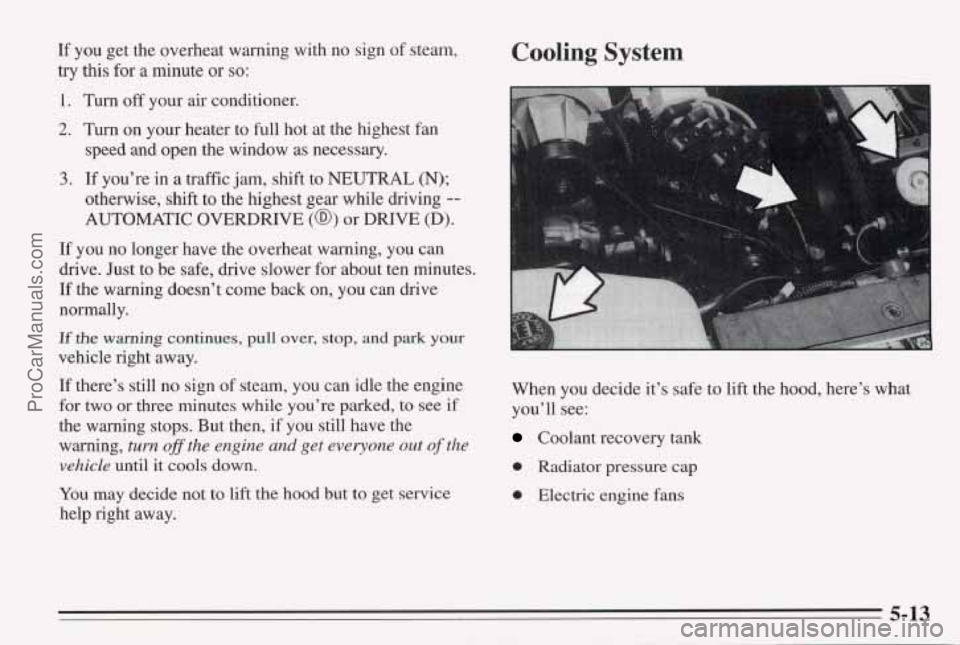
If you get the overheat warning with no sign of steam,
try
this for a minute or so:
1. Turn off your air conditioner.
2. Turn on your heater to full hot at the highest fan
speed and open the window as necessary.
3. If you’re in a traffic jam, shift to NEUTRAL (N);
otherwise, shift to the highest gear while driving --
AUTOMATIC OVERDRIVE (@) or DRIVE (D).
If y’ou no longer have the overheat warning, you can
drive. Just to be safe, drive slower for about ten minutes.
If the warning doesn’t come back
on, you can drive
normally.
If the warning continues, pull over, stop, and park your
vehicle right away.
If there’s still
no sign of steam, you can idle the engine
for two or three minutes while you’re parked, to see if
the warning stops. But then, if you still have the
warning,
turn off the engine and get everyone out of the
vehicle until it cools down.
You may decide not to lift the hood but to get service
help right away.
Cooling System
When you decide it’s safe to lift the hood, here’s what
you’ll see:
Coolant recovery tank
0 Radiator pressure cap
0 Electric engine fans
5-13
ProCarManuals.com
Page 224 of 338
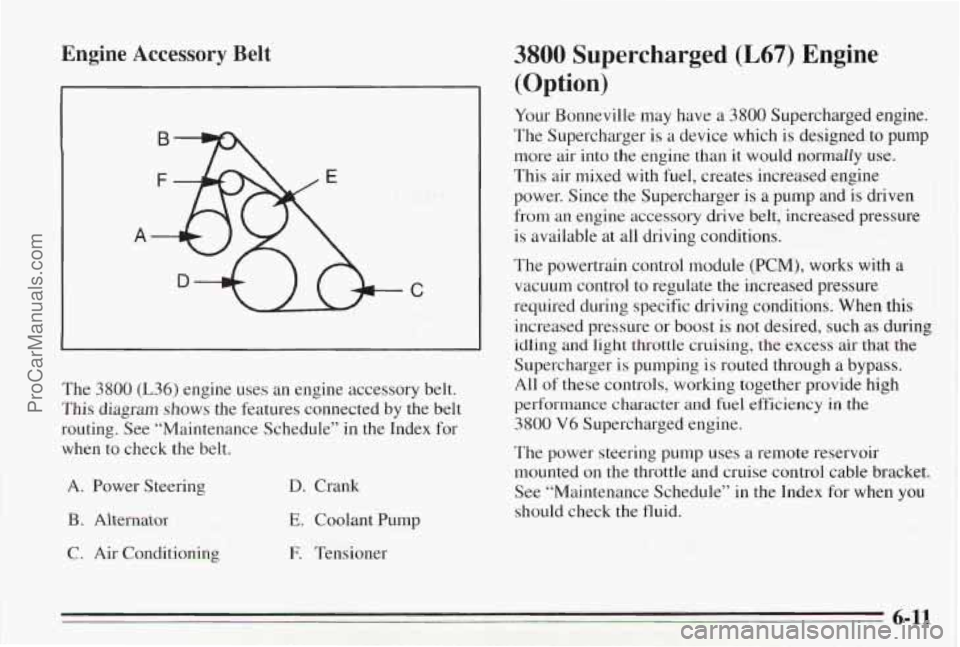
Engine Accessory Belt
A
C
The 3800 (L36) engine uses an engine accessory belt.
This diagram shows the features connected by the belt
routing. See “Maintenance Schedule” in the Index for
when to check the belt.
A. Power Steering
B . Alternator
C. Air Conditioning
D. Crank
E. Coolant Pump
E Tensioner
3800 Supercharged (L67) Engine
(Option)
Your Bonneville may have a 3800 Supercharged engine.
The Supercharger is
a device which is designed to pump
more air into the engine than it would normally
use.
This air mixed with fuel, creates increased engine
power. Since the Supercharger is a pump and is driven
from an engine accessory drive belt, increased pressure
is available at all driving conditions.
The powertrain control module
(PCM), works with a
vacuum control to regulate the increased pressure
required during specific driving conditions. When this
increased pressure or boost is not desired, such as during
idling
and light throttle cruising, the excess air that the
Supercharger is pumping is routed through a bypass.
All
of these controls, working together provide high
performance character
and fuel efficiency in the
3800 V6 Supercharged engine.
The power steering pump uses a remote reservoir
mounted on the throttle and cruise control cable bracket.
See “Maintenance Schedule”
in the Index for when you
should check the fluid.
6-11
ProCarManuals.com
Page 225 of 338
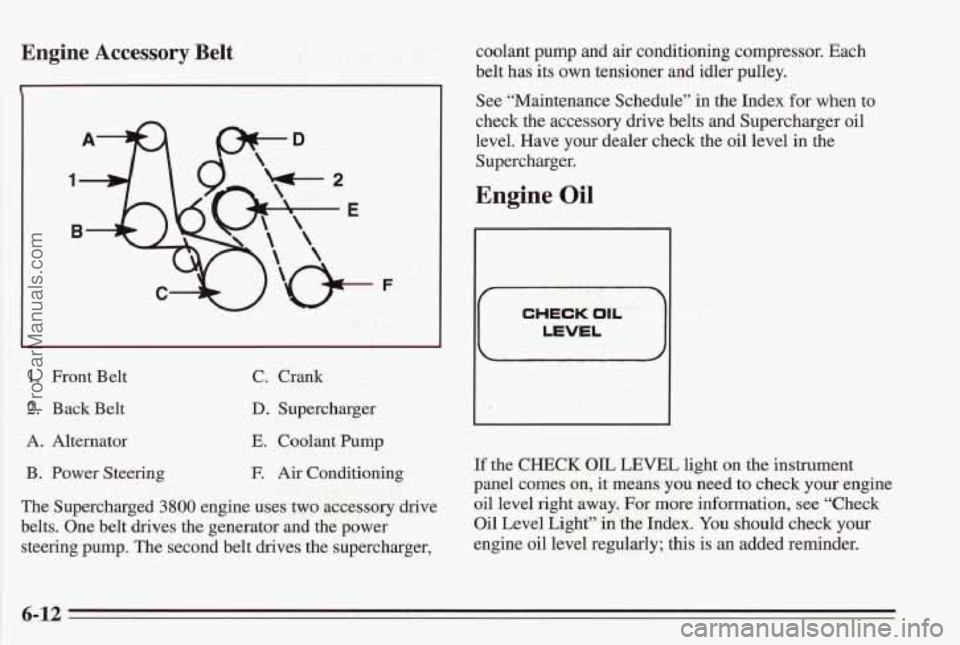
Engine Accessory Belt coolant pump and air conditioning compressor. Each
belt has its own tensioner and idler pulley.
1. Front Belt C. Crank
2. Back Belt D. Supercharger
A. Alternator
E. Coolant Pump
B. Power Steering E Air Conditioning
The Supercharged
38800 engine uses two accessory drive
belts. One belt drives the generator and the power
steering pump. The second belt drives the supercharger, See
“Maintenance Schedule” in
the Index for when to
check the accessory drive belts and Supercharger oil
level. Have your dealer check the oil level in the
Supercharger.
Engine Oil
CHECK OIL
LEVEL
If the CHECK QIL LEVEL light on the instrument
panel comes
on, it means you need to check your engine
oil level
right away. for more information, see “Check
Oil Level Light” in
the Index. You should check your
engine
oil level regularly; this is an added reminder.
6-12
ProCarManuals.com